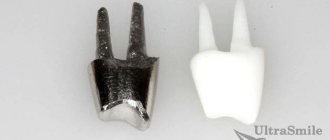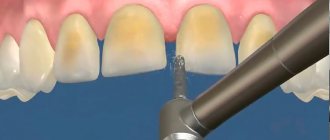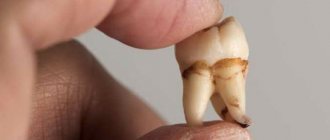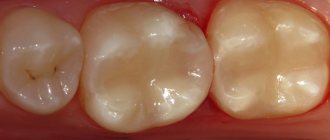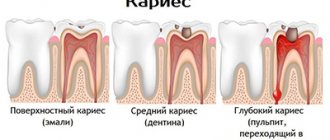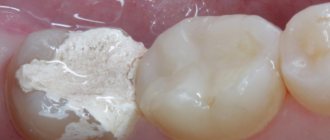Date of publication: 20-11-2018 Date of update: 19-03-2021
Author of the article: Shamray Olesya Vladimirovna Dentist
Patients make a serious mistake when choosing tooth extraction or replacement with a denture instead of treatment. Since the load and responsibilities of each tooth are clearly adjusted and distributed by nature, dentists always recommend treatment. The most common treatment method in dental practice is the installation of a filling to restore the aesthetics and, most importantly, the chewing functions of the teeth.
The function of chewing food, as well as the main load, is borne by the chewing teeth: molars and premolars.
The greatest load during chewing food falls on the large and small chewing teeth. They have more substantial roots and a wide surface, which is called occlusal or occlusal. The safety of the chewing part of the tooth determines the complete consumption of food, its correct grinding before entering the stomach, as well as the distribution of the load on the remaining teeth. Therefore, when restoring them, it is important that the filling is anatomically correct: it has irregularities, tubercles and higher edges. Only such a filling can fully participate in the chewing process and perform the functions of a healthy tooth. The material must also meet the general requirements:
- Fit tightly. This will help protect the tooth from infection and prevent secondary caries from developing. Further tooth decay will also be stopped.
- Have high strength and indestructibility by saliva. The filling must withstand constant mechanical stress during chewing, be subject to little wear and not be destroyed by acids in saliva. Of course, any fillings will require replacement over time, but the right ones will last for several years.
- Have a neutral composition. Often the nerve is not removed before filling so that the tooth remains alive longer. The filling should not release any compounds that affect nerve endings.
It is better to leave the choice of material to the dentist; it will be based not only on your financial capabilities, but also on the feasibility of using the material, its service life and the individual characteristics of the dentition.
After filling the chewing teeth, it is worth protecting them from strong mechanical stress.
In what cases is it necessary to install a filling?
The installation of restorative material is carried out not only in the treatment of carious lesions. The procedure is also performed when:
- presence of chips and cracks;
- elimination of consequences after mechanical damage;
- intense loss of hard tissues, leading to almost complete wear of the upper part of the teeth (for example, due to involuntary grinding of the jaws).
It is worth noting that any dental clinic performs filling only in cases where the destruction of the coronal part is insignificant. If the surface of the tooth is damaged by more than a third, it is replaced with an artificial substitute - a prosthesis.
The use of modern materials helps restore the beauty of the smile and chewing function, and also prevents further destruction of the mineralized coating.
Installation procedure
First you need to make sure that the molar is healthy and the oral cavity is in proper hygienic condition. It is advisable to have it professionally cleaned if it has not been done for a long time. Next, it is necessary to perform anesthesia, if we are not talking about a pulpless tooth.
The preparatory stage continues with the drilling of the affected tissues, which need to be replaced with filling material. After all excess has been removed, a suitable environment is provided using cotton balls and a saliva ejector.
Next, the filling material is directly applied, and special light lamps are used to record the result. Afterwards, the light fillings can be polished and ground to give not only a natural appearance, but also to maintain a comfortable feeling in the mouth. To give additional strength, insulating gaskets and bonds, that is, special adhesive systems, are used. At the end of the entire procedure, varnish is used.
What is taken into account
The peculiarity of installing geleocomposite fillings is that the material must be applied gradually in thin layers. Otherwise, due to rapid hardening, strong pressure may arise inside the tooth and its integrity may be in danger. Today, a specialist receives materials in portions, these are ready-made volumes of photopolymer. Thanks to this approach, the dentist does not spend extra time mixing components; the hygiene of the process is also not the least issue.
What types of fillings are there?
Depending on the period of use, temporary and permanent fillings are distinguished. The first ones are placed during treatment. For example, they cover a tooth for a while in order to understand whether the nerve is affected by caries or not. A temporary filling is also used to secure medications placed in a diseased tooth, or to secure arsenic after depulpation. After two weeks, temporary materials are replaced with permanent ones. The latter can last for years.
In modern dentistry, the following types of fillings are distinguished:
- Cement fillings are a budget option. They are difficult to grind, look unnatural and can cause destruction of the teeth they interact with.
- Metal (almagamic). They are made from an alloy of silver and copper, are characterized by increased strength, but also stand out against the background of the rest of the jaw. Often, fillings of this type are installed on teeth located further than the incisors.
- Composite fillings. They have a paste-like consistency and are applied in layers, so working with them does not cause much difficulty. Special ultraviolet light is used to fix composite materials. The variety of the palette allows you to choose a shade that will not differ from the native enamel, which is why composites are widely used for the restoration of anterior teeth.
- Ceramic fillings. In appearance and composition, they are as close as possible to the natural coating of teeth. Their production takes some time, so the fixation of the material is carried out in several stages. Ceramics are resistant to temperature changes. Its main advantage is also aesthetics.
Materials used
A light-curing filling is made from a special composite, the composition of which varies depending on the application. The principle of operation is the same - under the influence of UV radiation, the process of decomposition of the substance and the start of polymerization occurs. Today, a light seal can consist of various materials that differ in particle size:
- Macrofillers;
- Microfillers;
- Mini fillers;
- Nanocomposites.
Each variety has its pros and cons; they are united by a high hardening speed and plasticity, which allows you to achieve excellent results. At the same time, a light polymerization filling made from a nanocomposite has the greatest number of advantages, such as high aesthetics, polishability, strength, minimal shrinkage, excellent marginal fit and much more.
What types of fillings are better?
Many dentists recommend installing fillings made of light-curing composite. They are characterized by increased strength and durability, and look natural. Composite fillings are suitable for filling cavities in distant teeth and restoring carious cavities, as well as for treating erosions of hard tissues. Their service life is 5 years.
Glass ionomer cement, which is a hybrid of acrylic and silicate components, is also considered a good choice for filling. Glass ionomer combines well with natural coatings and other established types of fillings; it is suitable for treating destructive processes of the tooth, filling the anatomical space under the roots, and preparing the cavity for further orthopedic manipulations.
How is a light seal different from a regular one?
In fact, the term “light filling” is more popular among the people, but experts usually use other names: photopolymer, light-curing, heliopolymer are the most common of them. A light filling is a fairly plastic material, and thanks to ultraviolet light it is much easier for a specialist to carry out a filling. This is the main difference between a light filling and a regular one. In addition, you can choose many colors and shades for a light filling, which is why it is so often used in the treatment and restoration of teeth in the smile area. In short, the main advantages of a light filling are reliability, durability and high aesthetics. These qualities make light-based dental fillings one of the most sought after in the dental market.
How is the filling installed?
The fixing of the restoration material always follows the same pattern:
- First, the doctor injects into the tissues located around the damaged area.
- When the medicine begins to act, the specialist cleans the cavity from the remains of dead tissue, darkened mineralized parts and dentin, and gives it the desired shape and depth.
- The doctor then examines the pulp. If the connective tissue is not damaged, the prepared area is treated with an antiseptic. If the pulp is in a state of inflammation, then the dentist removes it from the tooth cavity and then fills the canals.
- After the above manipulations, the cavity is dried. Then special antimicrobial and insulating gaskets are placed in it.
- At the final stage, filling is carried out. At the end of the operation, the installed material is ground for comfortable closure of the jaws and polished.
What determines the service life
A light-curing filling can last up to 5 years and no problems will arise with it. But of great importance, for example, is the diet that the patient will adhere to after this. A high content of carbohydrates in the diet reduces this indicator, but the inclusion of plant foods in it, on the contrary, allows it to last for as long as possible. In this case, good grip is guaranteed by several factors:
- Under the influence of ultraviolet radiation, a chemical process occurs between the filling and the tissues of the tooth itself with the help of calcium;
- Before installing the filling, the tooth body is treated with adhesive, which is also illuminated with a lamp.
To ensure that the service life of the light seal is not reduced, the specialist must follow the technology in the smallest detail, which requires excellent professional training.
After teeth filling
In some cases, after applying a filling, the sensitivity of the sealed tooth to external factors may increase: it may “ache” unpleasantly with any temperature change or when air enters. This most often happens when using composite materials. If the tooth remains sensitive two weeks after treatment, you should immediately consult a doctor.
A common cause of pain that occurs immediately after the anesthetic wears off can also be an excessive filling height. In this case, it should be reduced by the dentist.
The application of a filling is always accompanied by final grinding, during which the edges may remain sharp. Due to the action of the injection, this is often not felt immediately. If you notice protruding edges after the anesthetic has worn off, you should contact a dental clinic as soon as possible and make an appointment to straighten the tooth surface.
What materials are used for such filling?
Let's consider all the options for filling materials that are used in Clarimed dentistry. They have proven to be the best in terms of price-quality ratio and help solve almost any problem with chewing teeth.
Glass ionomer cement (GIC). This is a modern cement material that is often used to install permanent fillings on the chewing surface. It hardens well in a humid environment, so it is also used to treat the most problematic types of caries, for example, those below the gum level. The material creates intermolecular bonds with enamel and dentin, therefore it holds well and does not require additional sites for strengthening. During the polymerization process, the cement material practically does not shrink, releases fluoride ions into the tooth tissue and adheres perfectly to the edge of enamel and dentin due to thermal expansion.
Make an appointment
Light-curing composite "Filtek". A light-curing nanocomposite material that has received medals in various dental competitions at the international level for several years in a row. It lends itself well to modeling, is aesthetic, elastic and very durable after hardening. Suitable for any carious cavities, retains its properties for a long time and is minimally susceptible to abrasion.
Liquid-flowing light-curing composite FLOW. Ideal for filling small carious cavities on chewing teeth. The material is aesthetic, well modeled, and durable.
Liquid-flowing light-curing composite Estelite. The highest award in the field of dental restoration, a kind of dental Oscar, according to the popular American magazine The Dental Advisor, was awarded to this Japanese filling material from 2010 to 2021.
Estelite is suitable for all types of carious cavities, gives minimal shrinkage when cured and has 20 shades that will completely restore the aesthetics of any tooth. This is the most wear-resistant material presented, it has minimal abrasion, and it is possible to restore both front and side teeth; cutting and chewing surfaces. The Japanese composition releases fluoride ions, therefore reducing the risk of recurrent caries. In addition, the composite is characterized by deep adhesion to dentin, resulting in a monolithic structure without a marginal gap.
If the filling is placed correctly on the chewing surface, then it is practically indistinguishable from a real tooth.
Rules for caring for fillings
Despite the fact that many fillings can theoretically last for years, it is recommended to change the materials every 10-12 years. It is recommended to visit a doctor once every six months for hygiene measures. You should also make an appointment with a doctor if:
- short-term pain in the treated area;
- detection of cracks;
- presence of a chip in the filling material.
The dentist can easily replace a bad filling with a new one.
If there is a large amount of restoration material in the cavity, you can ask the specialist to prescribe a gel with a high fluoride content. Its regular application will help strengthen the hard surface and prevent caries from forming again. Filled teeth may also be coated with fluoride varnish during the examination.
At home, it is recommended to use mouth rinses. With their help, you can significantly reduce the number of microbes that cause caries.
Summarizing the above, I would like to note that filling is a serious procedure. To prevent dental treatment under anesthesia from ending with repeated fillings and a double waste of time and money, you should seek help only from reliable, experienced specialists.
Tooth restoration with a ceramic inlay.
The inlay is a microprosthetic tooth. In the process of restoring teeth with a ceramic inlay, the treatment process itself is faster. This is especially true if several teeth are subject to such treatment. The doctor prepares the cavity of a tooth (or several), takes impressions (molds) and installs a temporary filling. The impressions are sent to the dental laboratory, where a technician makes the inlay with perfect precision. At the next appointment, the specialist removes the temporary filling and installs the finished inlay into the tooth cavity using a special adhesive material. There is no need to sit in a chair with your mouth open for a long time, as is the case with layer-by-layer fillings. If we are talking about several teeth, then the filling process will have to be extended over several visits. In the situation with inlays, this can be resolved in 2 visits to the doctor.
| Advantages of a ceramic inlay over a filling. |
|
|
|
|
|
|
|
|
|
|
| Disadvantages of ceramic inlays. |
|
|
Contraindications for installing a tab.
Despite all the advantages, there are a couple of points in which this microprosthetics is impossible:
- The tooth is more than half destroyed. If, after treating the affected surfaces, very little tooth tissue remains, then it is recommended to install a crown on the tooth.
- If the development of caries occurs in a very hard-to-reach place, in this case a filling is installed.
As can be seen from the comparison tables, inlays have virtually no disadvantages compared to fillings.
How much does a filling actually cost?
But now you come to dentistry, and the doctor offers you a choice of several types of light fillings, of which the cheapest can cost (relatively) from 1,500 rubles, the middle price segment - about 3,000 and the most expensive - 5,000 or more... And which one to choose ?
In the dentist’s office there is hardly anyone to ask: the dentist and the clinic, of course, are interested in selling the most expensive product. And usually the patient has to rely on the integrity of the doctor and accept the choice that the dentist himself offers. We want to help you make an informed choice of filling that meets your needs and capabilities.
So, what does the cost of a filling consist of (in this article I consider only the filling, without taking into account the cost of root canal treatment):
1. Qualification: here we record annual additional professional training and courses (all doctors in our dentistry spend from 30,000 to 150,000 rubles for these purposes every year). You have to save from each filling =).
2. Equipment: standard equipment for a dental office to provide the usual range of services costs from 500,000 to 1,500,000, and this does not take into account the cost of equipment for the X-ray room and sterilization room. To place the most ordinary filling without pain and unnecessary injury, you need a high-speed, water-cooled installation.
3. Premises maintenance or operating expenses: this includes licensing, premises rental, insurance, cleaning, assistant, administrator. It is unlikely that it will be possible to calculate correctly, but in the case of our clinic, each patient’s appointment costs at least 1000 rubles, regardless of the service provided, even if it is just a consultation =). If you are from Moscow, then, by the way, you can sign up online.
4. To install a filling, you also need tools of limited use (short service life or disposable) - such as burs, rubber bands, grinding discs, strips, brushes, wedges, matrices, etc. Yes, these “small things” also add up to a decent amount .
5. Cost of a filling : “Well, finally!”, you say. But it’s not that simple... Before announcing the nominal cost of a filling (filling material), I urge you to review the points above again: without them, this price in no way reflects the cost of the work to install the filling. It is also obvious that the amount of material required to treat a particular tooth is always individual. So, we have an aesthetic dentistry clinic and we use only materials in the “above average and premium” price segment. The material that we usually use for the restoration of chewing teeth costs about 5,000 rubles per syringe (about 10 fillings).
It would seem that what prevents you from putting a cheap filling on an expensive material if it is so inexpensive in itself? Probably nothing. Only I don’t know of such examples.
If dentistry or a dentist, or a clinic saves on good equipment, quality of repairs, advanced training and tools, do you really think that they will choose expensive material for you?
Buying expensive filling material yourself is also not an option. Each material has its own properties and you need experience in its use, or advanced training courses, to get high-quality work.
But if the doctor offers several options for fillings to choose from, it is worth choosing, of course, in favor of the more expensive material.
